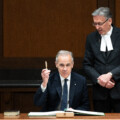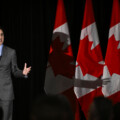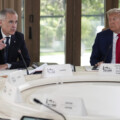In August of 2007, I strolled up the driveway of the Governor General’s residence, Rideau Hall for a cabinet swearing in ceremony. My next stop was my minister’s department: Industry Canada.
A policy priority for us was the upcoming Advanced Wireless Spectrum auction. AWS is a wireless telecommunications spectrum band used for mobile voice and data services, video and messaging. Pre-billed as a policy to lower prices through more competition in the cell phone market, the details remained for department officials to advise and the minister to decide. I would be the guy in the middle. Working with officials, debating, scrubbing, mapping, incorporating the minister’s values and judgement, and knitting together political and public interest matters.
The end product of the work can be found in the 2007 AWS spectrum auction framework and the subsequent auctions which now form a major subset of the 15-year history of inertia in Canada’s telecom/broadcast and internet policy.
What follows are my thoughts on why the policy failed. And why the failure doesn’t matter and an outline of a new policy approach reflecting other events since 2007.
Key factors that contributed to the policy’s failure were specific to the initial auction while others migrated into future auctions and one was a critical policy choice unhelpfully left out of the framework.
Timing. The auction was held very close to the 2008 financial meltdown and related credit crunch. The financial scaling of new entrants began shortly afterward and proved to be less than ideal.
Continuity. A change of minister in November 2008 was unhelpful. The policy development was initially led by a minister who knew and understood all proponents, market dynamics, and corporate relationships across the industry. I mean no disrespect to those who followed, but simply observe that the minister who created the policy would likely have had a stronger hand in its implementation.
Policy consistency. Cabinet overturning a key CRTC decision on the foreign control status of one of the new entrants was unwise. The rules, in my view, were clear. There, the auction proceeds from the new entrant should have been retained, the new entrant disqualified, and its spectrum re-bid, possibly with a set-aside. Given all the churn amongst incumbents and new entrants, government efforts to preserve one additional new entrant at the expense of time and political capital were disproportionate to its importance.
Usage. Deployment of spectrum became and remains a serious problem. I’m not an advocate of “use it or lose it,” but I do wonder the result had governments enforced usage in a consistent and escalating manner, up to and including revoking licenses. In private sector hands, a licensed public asset (in this case unused spectrum), is converted into a bankable asset. If it’s just sitting on a corporation’s balance sheet accruing value, that’s a private, not a public benefit.
Network access. Lastly, the initial and subsequent policy left the matter of network access to commercial terms, negotiated between commercial parties. Some favoured a third-party arbitration model. Ultimately, in my view, its absence is the main reason the policy failed. New entrants, particularly those who couldn’t trade services or assets had no leverage in “commercial” negotiations with what are in effect oligopolies. Most players wishing to access a competitor’s network infrastructure, then and since, get access only if it accords with the business interests of the owner, at rates that reflect the interest level, which are too often higher than commercially justified and inherently anti-competitive.
In summary, the 2007 policy leaned into bundling of telecom, internet, cable, and cell under one bill to advantage new, regional entrants and vague terms of network access for non-bundled new entrants as stand-alone national carriers. More than fifteen years later, the policy has been given time and it hasn’t worked.
What’s next?
Fixing the price problem won’t come from tweaking the policy to fix the flaws noted above and subsequent others. To me, that would be akin to attempting to bail out a boat that’s sitting at the bottom of a lake.
Some say bring in foreign competition. I’m pretty cold on that. First, outside trade negotiations, unilaterally surrendering a great market to foreign operators is unwise. It’s also naive to think foreign operators would be any different than Canadian companies. The big difference for policymakers and consumers would be access to ultimate decisionmakers and leverage over same. In the auto sector, for example, big decisions get made outside of Canada. I don’t think we would be well served by adding telecom, cell, cable, and internet services to that mix.
Ultimately a policy based on the flawed assumptions made two decades ago—layered onto decades-older public interest tests that drove the development towards today’s telecom/cable/ broadcast and internet conglomerates—will give you a policy that boldly goes where we’ve always been. On the cutting-edge of tradition. Inevitably dealing with legacy issues first while relegating new opportunities to a later date.
The better path forward is to part ways with legacy policies through a two-pronged approach.
First, we should embrace the lessons from a far more successful 2007 launch: the Apple iPhone, the App Store, and the sea change it and related technologies have brought to markets, business, jobs, lifestyles, and broad societal use of information technology.
Second, we need (here and across a range of institutions and policies) to renew the public interest tests at hand. In this case, we’re dealing with different tests that were once separate but now, by way of technology convergence and corporate mergers, have concentrated market power in a handful of dominant operators, resistant to competition and hostile to lower prices. Given these well-established facts, the onus is now on government to rebalance the public interest test to reflect today’s public interest.
From my perspective, today’s public interest would boil down to one outcome and one deliverable.
The outcome would be the strongest information technology infrastructure in the world, universally accessible, anywhere in Canada.
The deliverable would recognize that the state and supported work best when the state steers towards clear, publicly understood outcomes and lets a singularly-focused organization get on with the work.
This two-pronged approach would narrow our policy focus to delivering accessible, affordable, ubiquitous, high-quality networks to all Canadians in all corners of Canada without compromise by mixing in other goals. The “pipes” matter. But it would also enable the information flow—where the value and future are being built. And where governments are ill-equipped—in comparison to users, consumers, and markets—to develop, deploy, pick, select, screen, or shape let alone envisage what that future will be.
The starting point for the new policy would be divestment of network infrastructure from the current owners and the creation of a set of national and regional networks as regulated utilities delivering open access to consumers at regulated rates of return. A publicly established, independently adjudicated price of access would be common to all consumers. Service providers would compete for consumer and other buyers’ business to add their service, and the costs, to the basic cost of network access.
Governments would retain ownership restrictions for the networks. Providers of additional services would face fewer if any such restrictions. And rather than impose antiquated Canadian content rules designed for a few hundred radio and television stations but poorly suited for thousands if not ten of millions of “stations” in the form of content creators, there would be a narrowing of effort to ensure prioritizing of support for indigenous Canadians (particularly in language retention, community development), official language groups, news (with an emphasis on local and regional news) and support for new Canadians in their integration into Canadian society.
The government(s) would also undertake a renewal of tax and income support policies to ensure they too, along with the infrastructure, have the appropriate incentives to ensure Canada is competitively positioned in attracting and retaining the economic and societal benefits of first-rate, affordable network access.
I’ll close with a quicker walk down memory lane. Charlie MacMillan was on The Hub recently. In the course of his conversation with host Sean Speer, he reminded me of the monumental work undertaken between 1984 and 1993. The Neilson Task Force, responses to the MacDonald Commission, reforming financial services, repealing odious restrictions in the energy and foreign investment space—they covered a lot of ground. Most of this good work is lost in history. Much of it is buried under an unhealthy instinct to simply condemn anything to do with the era.
But then as now, there was a list of policies and moribund organizations in Canada who enjoy privileged access to a public asset (airports, ports) or public markets (telecom, banks, airlines) or public money (crown corporations and agencies various) who were estranged from the public interest test that enabled their privilege.
More troubling, so were the keepers of the public interest inside government. Sean Speer wrote about this in his commentary on the CBC. In my words, the public interest test that led to the creation of the CBC and countless others have been lost in time. It’s unhealthy when the public is left to wonder why things are the way things are.
The public has had enough of ‘it is that way just because’. Canadians deserve a serious, detailed response to their demands for change. Banks that are inaccessible to too many marginalized Canadians. Government services that don’t service. Airlines and regional transportation systems servicing fewer and fewer communities. Police forces who don’t police. Unarmed Armed Forces. Environmental review processes that don’t process anything.
So, there’s another pile of work ahead for anyone interested in doing it. Finally developing an up-to-date national information technology policy would be a good place to start.
Recommended for You

The Notebook by Theo Argitis: Carney’s One Big Beautiful Tax Cut, and fresh budget lessons from the U.K.

Ginny Roth: How vacant liberal nationalism left Canada worse off than George Grant even imagined

Peter Menzies: Justin Trudeau’s legislative legacy is still haunting the Liberals

‘Our role is to ask uncomfortable questions’: The Full Press on why transgender issues are the third rail of Canadian journalism



